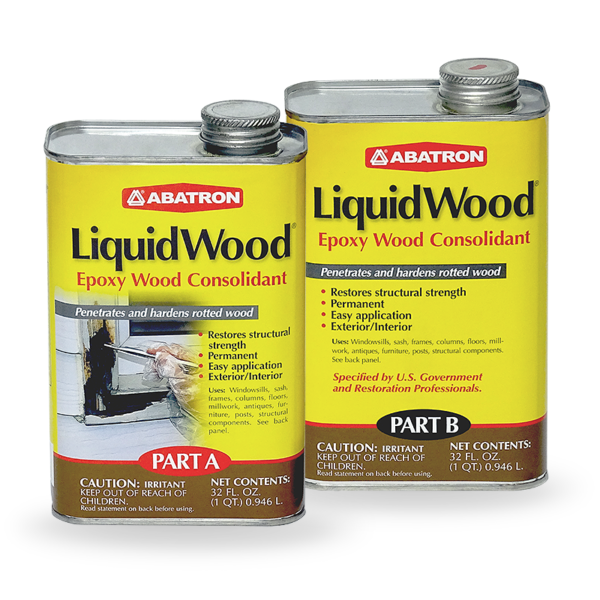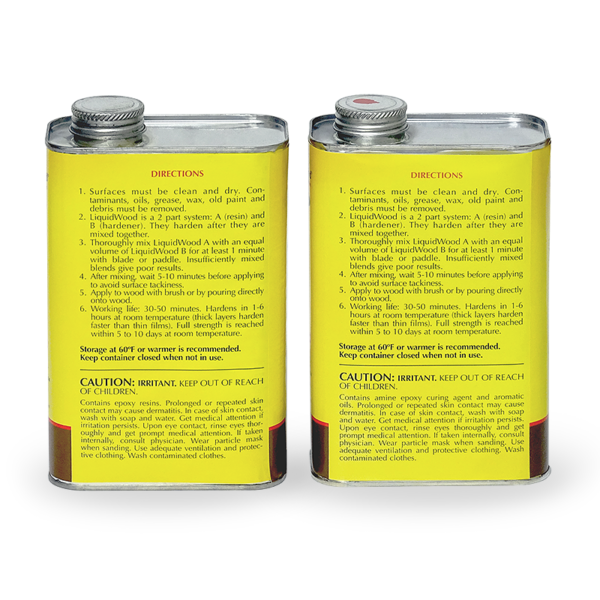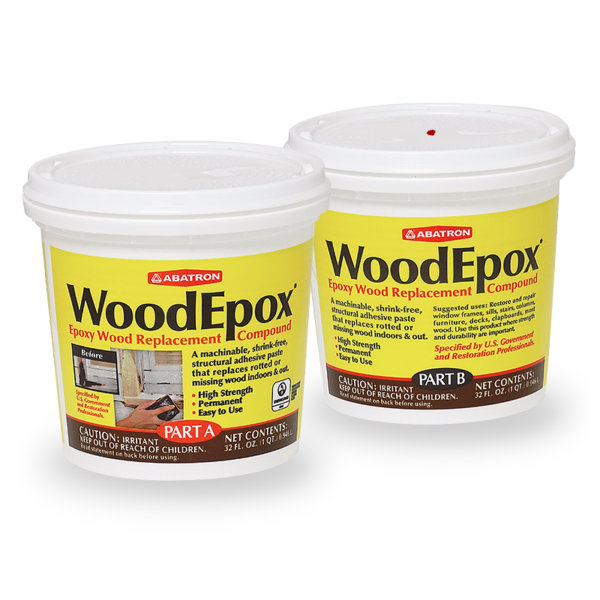LiquidWood®
Structural Epoxy Wood Hardener and Consolidant for Deteriorated Wood.
Uses: LiquidWood® penetrates wood fibers and structurally hardens decayed and weathered wood permanently. Use indoors and outdoors and on both structural and decorative wood. Use to harden and restore wood on buildings, windows, columns, beams, decks, boats, furniture, artwork, and any wooden architectural elements. Use also as a primer or thinner for WoodEpox®.
Features & Benefits: LiquidWood epoxy wood consolidant is easy to use and produces permanent results. Its low viscosity allows it to penetrate deep into the wood and saturate deteriorated wood fibers prior to hardening. This eliminates the need to remove the areas that can be effectively consolidated. With LiquidWood, deteriorated wood that could crumble under finger pressure can be restored to structural, high-strength, durable, weather and insect-resistant wood. The absence of water and solvents eliminates shrinkage and enhances adhesion. It is low odor and produces virtually zero VOCs, making it safe and hazard-free in any environment. Treated wood will harden within hours, and like new wood, can easily be sawed, planed, drilled, nailed, painted, routed, and sanded.
Technical Characteristics: 1:1 mixing ratio. Combine equal parts A and B until fully blended. Pot life: approximately 30 minutes. Hardens within hours depending on temperature and other environmental factors. 100% epoxy solids. Waterproof. Coverage: 231 cubic inches per gallon. Effective coverage varies based on the porosity of the wood. Translucent amber color liquid resin. Apply by brushing, pouring, or injecting directly onto dry, bare wood. Application temperature range: 50-90° F. 100% compatible with WoodEpox.
Cold weather formulation is available for application temperatures as low as 35° F.
 This product is GREENGUARD® Certified, meaning that it has been 3rd party verified to contain virtually no VOC’s (volatile organic compounds).
This product is GREENGUARD® Certified, meaning that it has been 3rd party verified to contain virtually no VOC’s (volatile organic compounds).
TYPICAL TEST RESULTS
| Kg/cm2 | Mpa | Psi | ||
| Compressive Strength | 366 | 36 | 5210 | |
| Elongation | 84% | |||
| Flexural Strength | 63 | 6.2 | 900 | |
| Hardness, Shore D | 42 | |||
| Tensile Strength | 103 | 10.1 | 1460 |
Wood Restoration with LiquidWood and WoodEpox
Learn the Basics - Mixing LiquidWood
Customer Questions & Answers
-
I have a few logs on my log cabin that have been damaged by powderpost beetles, should I apply the liquid wood first and then spray to kill the Beatles or spray to kill the beetles first?
-
Q I have a few logs on my log cabin that have been damaged by powderpost beetles, should I apply th...... Read more answer nowAsked by on December 18, 2022 8:46 pmAnswered by the admin
You should apply the product for killing the beatles first, allow the wood to dry back out, then you can apply the LiquidWood to any soft and/or rotted wood areas.
Can LiquidWood be used to seal and restore painted wood siding that is beginning to show cracks, but does not show signs of crumbling?
-
Q Can LiquidWood be used to seal and restore painted wood siding that is beginning to show cracks, ...... Read more answer nowAsked by on November 30, 2022 1:42 pmAnswered by the admin
No. LiquidWood should only be used to consolidate rotted wood, and should be applied to the bare wood. It is not a protective coating or sealant.
Answered by the adminNo. LiquidWood should only be used to consolidate rotted wood, and should be applied to the bare wood. It is not a protective coating or sealant.
Yes,when putting product on wood and the end grain can't be used should I drill the wood an inject or just brush several coats? The dry rot is near the end of the joist.
-
Q Yes,when putting product on wood and the end grain can't be used should I drill the wood an injec...... Read more answer nowAsked by on November 14, 2022 8:57 pmAnswered by the admin
You can apply the LiquidWood by brushing it on in layers until no more product absorbs. If you think the rot goes deeper into the wood, you can drill holes and inject it.
I use west systems epoxy for many of my long assembly and clamping projects. I currently am restoring some badly deteriorated wooden sashes as their mortise and tenon joints have failed and ~25% of the joint is missing due to rotted wood. The restoration has three requirements; hardening of the remaining wood for both the tenons and the mortises, glueing the parts together, and filling the voids where wood is missing. Can I use liquidWood as both the wood hardener and epoxy adhesive? Also, will the WoodEpox have adhesive issues if the LiquidWood is allowed to fully cure before applying the WoodEpox?
If the LiquidWood is not suitable as an epoxy adhesive is it compatible with an epoxy like West Systems? Is there a requirement to apply the epoxy adhesive when the liquid wood is still tacky? Thanks
-
Q I use west systems epoxy for many of my long assembly and clamping projects. I currently am resto...... Read more answer nowAsked by on November 4, 2022 7:51 pmAnswered by the admin
You can use the LiquidWood to consolidate the rotted wood. You can also use it as an adhesive as long as you are able to clamp the pieces together until the LiquidWood is cured. If the LiquidWood fully cures prior to the WoodEpox application, you can just apply another thin layer of LiquidWood, allow it to get tacky, then apply the WoodEpox.
I have a 1-pint container of LiquidWood Part A that still weighs 9oz, however when I went to use it today hardly anything pours out because the clear Part A solidified in the bottom. Can it be warmed up similar to WoodEpox Part A, or is there really nothing I can do except buy another 2-pint kit?
-
Q I have a 1-pint container of LiquidWood Part A that still weighs 9oz, however when I went to use ...... Read more answer nowAsked by on November 2, 2022 10:28 pmAnswered by the admin
It does sound like your LiquidWood is crystalized. You can try warming it using the hot water method to see if that will make the product more fluid.










 Technical Data Sheet
Technical Data Sheet


j thomas –
Mixing: I use a pair of clear 9oz drinking cups that have horizontal grooves molded in, so it’s easy to get the same level on part A and B. Pour each into a sandwich size ziploc, press out most of the air, and zip shut. Now it’s easy to mix together by kneading the bag. Wait the 10 minutes before using.
It’s usually 4-6 oz of each A and B. I can’t apply much more than this quantity before the epoxy starts thickening on a warm day, so I apply, then make another batch. The same weathered wood often needs this second application anyway.
I use “condiment bottles” from the supermarket (like ketchup bottles). Cut off the corner of the bag, and pour into the bottle, then squeeze out the remainder. This is so easy to apply to a vertical surface with the bottle. As I apply it, I use a disposable “chip brush” to pull the dripping epoxy upwards.
The bottles can be reused if turned upside down to drain completely. The remaining cured epoxy pulls right out of the bottle in one sheet.
Have a large cardboard box or garbage bag lined container. It’s for holding the many paper towels that get used for a session. And the A&B cups, ziploc bags, and used brushes.
Donald Chester –
A hint I might add: After making a small repair using a disposable brush, instead of throwing away the brush, I seal it into an air-tight zip-lock bag and place in the freezer. Even months later, I can take out the brush, let it come to ambient temperature, and it will be perfectly usable. This saves using a new disposable brush each time when I may be applying a small amount every day or two while working on a project, and I don’t end up having to throw away a bag full of hardened disposable brushes.
Donald Chester –
I have used Liquid Wood for years to maintain our 80+ y.o. old buildings. It is the most satisfactory repair product I have yet to try; it does not shrink, and is the only product I have used for both exterior and interior repairs, in which the hardened filler did not eventually separate from surrounding wood, inviting more water ingress and further rot. Repairs I made on wood siding and window sills 20 years ago still appear intact, and hold paint equally well to untreated wood.
I prefer to make my own filler by mixing fine sawdust with Liquid Wood, to WoodEpox. For one reason, after sanding over the repair, it becomes almost indistinguishable from the original wood, other than being a little darker in colour, whereas WoodEpox is stark white making the repair highly visible, particularly on surfaces like varnished flooring and trim.
Although the instructions say not to use it as a sealer, I find that it works well for sealing the ends of sawed pieces, which may wick up moisture and cause soft spots to eventually appear as far as several inches from the end. I use it to seal questionable pieces of old wood, even when I am not sure if it has started to decay. From my experience, if the piece of bare wood soaks up slightly thinned Liquid Wood, it serves a useful purpose. If it does not soak into the wood, it would be a waste of the product to apply it.
One word of caution: be sure to use protective gloves, and clean up per instructions. Otherwise, it may cause a rash similar to poison ivy, and subsequently, increased allergic sensitivity to the uncured product. I discovered that the hard way.
ABATRON –
Thanks for the feedback. We do suggest a longer induction period in order to avoid the tacky-blushing. 5-10 minutes is recommended. Humidity and moisture in the wood can affect the tackiness as well. Using an external heat source can speed up the cure significantly as well.
William H –
The product does what says, but takes a L-O-N-G time fully cure. Both times that I have used it, after 12 hours at ambient temperature (60-80 deg F) the surface is still very tacky. Now, I will say that after I mixed it well a good full minute, I let it sit for the mix to go from foamy to de-air and become clear. Maybe waiting longer would reduce the tackiness, but it took me about 15 minutes to fully apply with a coarse haired brush, so I was confident that the length of time and the constant applying should have given me the required time to not experience tackiness.
Product does what is says as far as binding wood and protecting it. But, if it that time sensitive regarding tackiness, I may look elsewhere for the next time.
ABATRON –
You can thin LiquidWood with Abosolv, Acetone, Xylene or Alcohol.
Er –
I have used it on an old log homes very satisfied with this product I was wondering how to make it thinner so it would penetrate the entire surface and get into the small cracks
Cheri –
I’ve used Abatron products in many areas as we’ve slowly restored our circa 1900 home. It’s easy to use, works perfectly, and has saved us a lot of money and hard work because we’ve restored the original wood parts – rather than replacing them.
Donald Chester –
I have used LiquidWood for years in restoration projects in and around my circa 1865 farmhouse and circa 1930 outbuilding. I prefer to make my own filler by mixing LiquidWood with fine sawdust, since after sanding, the colour comes out close to that of the surrounding wood even before finishing; sometimes it is hard to see where the repair was made, for example, where I repaired a burnt spot in my oak hardwood floor from an errant ember from the wood stove. I have used this method outdoors to repair rotted window sills and siding. It doesn’t shrink and after more than a decade, no cracks have appeared between filler and sound wood. Filled spots take paint just like original wood.
ABATRON –
It’s hard to say how much LiquidWood will absorb into the rotted wood because we don’t know the extent of the rot. You should keep brushing it on and/or injecting it until the product pools on the top, then you know you’ve applied enough product.
Ed –
what is the ration of liquid wood to the beam one would be working with?
ABATRON –
Yes, you can drill holes and inject the LiquidWood.
Chiya –
I have soft spots in my floorboards throughout my custom renovated home. The top layer of teak flooring is in great shape. Can I somehow inject the liquid hardener into the soft spots to fix the rotted boards below?
Anthony Smiley –
I use the Wood sealer 1st . Then I used the wood filler. Both products were easy to work with. I was repairing a rotted 2 by 12 joist. The wood sealer made the would extremely hard again. I then use the would filler to fill in the large Spaces. The A and B wood filler was like playing with clay . Very easy to use. I will give it a five star after I sand and shape the wood. Ps I have pictures if you would like to see them. Let me know.
Laurel –
none better!
eugene weddle –
good
James Listman –
This stuff is a mandatory for anyone with an older home trying to maintain old sills etc. Making sure the old wood is dry is critical. It sucks right in and truly does make the original better!